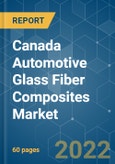The automotive glass fiber composites market is expected to register a CAGR of over 3%, during the forecast period, 2020 - 2025.
Key Highlights
- The major growth drivers associated with this market are the rise in automotive production and the increasing demand for durable and lightweight materials because of stringent government regulations to reduce greenhouse gas emissions
- The future of the global automotive glass fiber composites market looks bright with opportunities in different automobile applications, such as interiors, exteriors, structural assembly, power-train and engine components, electrical and electronics, and others. The market for glass fiber composites in automobile structures is expected to be the fastest-growing segment, due to the wide variety of applications.
- Strategic alliances between car manufacturers, glass fiber, and resin suppliers are the trends that have a direct impact on the dynamics of the automotive composites industry. Within the intermediates type, short fiber thermoplastic (SFT), long fiber thermoplastic (LFT), and continuous fiber thermoplastic (CFT) are the major ones that are used in automotive applications. SFT is expected to be the largest market by value, mainly driven by applications in power-train and engine components applications, which feature small complex-shaped components.
Key Market Trends
Increasing Adoption of Glass Fiber Composites in Automobiles
Although automobiles have been around for more than a century, the materials they are made of have mostly remained the same. Only since the past few decades that advanced materials, ranging from magnesium alloys to glass fiber composites, have made their way into new-generation cars. Advanced materials, such as glass fiber composites, are essential for boosting the fuel economy of modern cars, maintaining performance and safety. Since it takes lesser energy to accelerate a lighter object than a heavier one, lightweight materials offer great potential for increasing vehicle efficiency. A 10% reduction in the vehicle’s weight can transpire to a 6-8% increase in fuel economy.
Glass fiber composites are materials that have become popular in the past few years. One of the reasons for fiberglass composite's relative success is that it has several advantages when compared to steel. It is corrosion-resistant, has significant chemical resistance, and is lightweight (three times less dense than steel). Fiberglass composite is mainly used in bumpers, hoods, and casings. Another area where this material is used is V-belts and timing belts, where glass strings are impregnated with rubber acting as reinforcement. Abrasion resistance is one other advantage of the fiberglass composite, which is why it is used for producing clutches and brake pads. Clutch disks are reinforced with woven fiberglass composites to maintain their integrity.
COVID-19 will halt the Growth of the Market
However, there is a slowdown in automobile sales and production which is because of the trade tensions between two major economies of the world China and the United States, also the ongoing Pandemic COVID-19 is also responsible for the slowdown in the economy as it has forced the world economy to lockdown for almost 3 months and now the growth is expected to resume in the second half of 2021, as the governments are providing stimulus to the demand as well as the supply side to revive the economy.
Competitive Landscape
The Canadian automotive glass fiber composites market is consolidated. Some of the major companies in the glass fiber composites market include Solvay Group, 3B (Braj Binani Group), Owens Corning, Veplas Group, and SAERTEX GmbH & Co.KG. The market is also characterized by the presence of much smaller players which deals with aftermarket products.
Additional Benefits:
- The market estimate (ME) sheet in Excel format
- 3 months of analyst support
This product will be delivered within 2 business days.
Table of Contents
Methodology

LOADING...




![Glass Fiber in the Global Automotive Composites Market: Trends, Opportunities and Competitive Analysis [2024-2030] - Product Image](http://www.researchandmarkets.com/product_images/12471/12471273_60px_jpg/glass_fiber_in_the_global_automotive_composites_market.jpg)



